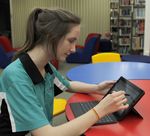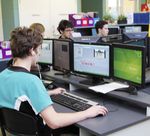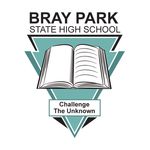Bray Park State High School - 2018 BYOD Program
←
→
Page content transcription
If your browser does not render page correctly, please read the page content below
Bray Park
State High School
2018 BYOD Program
Information Pack and Device Guide
for year 7, 8, 11 & 12 studentsWhy BYOD? The purpose of schools has always been to prepare students for life in a rapidly evolving world. BYOD (Bring Your Own Device) is a powerful initiative being utilised in industries around the world. It has been found that a successful BYOD program instils a technological self-sufficiency in individuals that utilise their personal devices to increase efficiency and boost morale. We endeavour for our school program to empower students to make positive decisions around self-discipline, work ethic and productivity by taking ownership of their tools, tasks and behaviour. Allowing students to bring their own personal mobile computing devices will contribute to increased education outcomes in many ways: Differentiation We understand that all students have unique learning styles. Allowing students to utilise devices they are comfortable and proficient with will reduce stress and anxiety and develop time management skills. Personal device also allow for greater customisation to suit specific needs. Personal Resources Having access to a personal resource such as an internet connection or unique hardware or software will enable access to a wider range of resources and learning opportunities. Device Proficiency Students are capable of amazing things when using their own personal device. Allowing them to bring a device they are proficient and experienced at using will lead to amazing outcomes in the classroom. Our Program Students can bring any Windows or Macintosh laptop computer which has a 13” screen or larger to use at school as their personal computing device. There are some restrictions and limitations however, these are outlined in more detail below. Staggered Rollout To transition from a laptop trolley school into a BYOD school, we will be continuing the rollout with Years 7, 8, 11 and 12 students in 2018. This staggered rollout will allow our network infrastructure to be progressively upgraded to manage the significant increase in active devices on our network. These students in 2018 will not have access to school laptops or computer labs and must bring their device to school charged and ready to use every day. As the BYOD program rolls out, school resources will be restructured for specialist purposes and to address any needs throughout the school.
Device Specification
The table below contains detailed information on hardware and software specifications to assist in selecting a
suitable device for your student to bring to school or if you are going to purchase a new device. We recommend
purchasing a laptop that fits the below specifications.
Minimum Device Specification
Device Type Laptop Computer
Screen Size 13” or larger
RAM 4GB
Storage 120 GB Hard Drive (SSD Recommended)
Suggested Processor Intel Quad Core or equivalent
Network 802.11n (2.4Ghz & 5Ghz) Not Supported – 802.11 Draft N
Operating System Windows 8, Windows 10
Mac OSX 10.8 or later
Not Supported – Linux (E.g Ubuntu, Debian, Fedora) and mobile operating systems ( iOS, Android, Windows RT)
Features Keyboard, USB Ports, headphone port, in built microphone, webcam
Battery life 6+ hours
Accessories Case/Carry Bag, Headphones, 4GB USB Flash Drive
Required Software
Internet Browsers Video Players
Google Chrome - http://www.google.com.au/chrome/ VLC - http://www.videolan.org/vlc/index.html
Firefox - http://www.mozilla.org
Audio Recording
Microsoft Office Audacity - http://www.audacityteam.org/
Free for all Education QLD students.
http://www.education.qld.gov.au/office2016 Virus Protection
Microsoft Windows Defender (included with Win-
Plugins dows 8 and Windows 10)
Adobe Flash - http://get.adobe.com/flashplayer/
Java - https://java.com/downloadBack Up Tips
Technology is not infallible and for this reason it is critical to keep a backup of all important files. Outlined
below are brief descriptions of the three main backup types:
Local: A local backup involves saving a copy of your files onto an external hard drive or USB. Both
Windows and Mac have inbuilt tools that can simplify this process.
Offsite: An offsite backup involves storing important data away from the primary source i.e. burning files
to a disk and storing it at a friend or family member’s house.
Cloud: While almost the same as an offsite backup, this method involves utilising cloud hosting services
(Drop Box, Google Drive, Microsoft One Drive, Apple iCloud or CrashPlan to name a few) to back up
your files to online data servers. Please note that all of the cloud hosting services do not work on the
school network but do work at home.
All of these methods by themselves greatly increase your chances of retaining important files after a catastrophe.
To maximise your chances of a successful recovery we would recommend at least using two of the three methods
listed above.
Care of the Device
Outlined below are the expectations regarding student responsibility for caring for their devices and ensuring
they are ready for school:
• It is the responsibility of the student to keep their chosen devices for school in working order to minimise
the disruption to learning.
• It is expected that students bring their devices to school each day fully charged. Limited charging facilities
will be available for student to charge their devices whilst at school.
• Students should take care when moving around school, as failure to do so can damage the Hard Drive
potentially losing data. Choosing a device with a Solid State Drive (SSD) can relieve some of these issues.
Virus Scanning
To ensure the integrity of our network and the safety of student devices it is imperative to establish a regular
“Full Virus Scan” schedule on your personal device. Suspicious links or email attachments should not be clicked.
Operating system updates should be regularly applied to keep the operating system patched from latest security
vulnerabilities.You can also read



























































